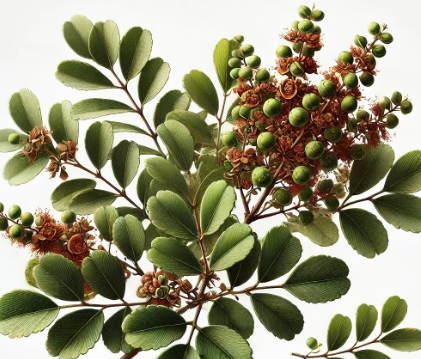The Santalaceae family, known as the sandalwood family, is a group of plants belonging to the order Santalales, comprising about 30 genera and over 400 species. These plants are primarily hemiparasitic, meaning they obtain part of their nutrients from host plants through specialized root structures called haustoria. Many species in the Santalaceae family are of great economic and cultural importance, especially for the production of aromatic wood like sandalwood and for their medicinal applications.
General Description
Plants in the Santalaceae family generally share the following characteristics:
- Parasitism: Many plants in this family are parasitic, particularly hemiparasites, which obtain nutrients from other plants (hosts) through specialized roots known as haustoria.
- Leaves: The leaves of Santalaceae plants are typically simple, opposite, or alternate, and can be fleshy or thin depending on the species. In some parasitic species, the leaves may be reduced or absent, such as in highly parasitic plants that depend almost entirely on the host for nutrition.
- Flowers: Flowers are generally small and are usually arranged in spike-like or racemose inflorescences. Many species have unisexual flowers, with dioecious (separate male and female plants) species being common. The flowers may be simple or highly specialized depending on the species.
- Fruits: The fruits are typically berries or drupes, containing one or more seeds. In some species, the fruit is dry and opens spontaneously to release the seeds.
Chemical Composition
The Santalaceae family is known for producing aromatic oils and other bioactive compounds, many of which have medicinal and therapeutic uses:
- Sandalwood oil (Santalum spp.): Sandalwood is one of the most important sources of essential oil. Sandalwood oil is rich in santalol, an aromatic compound known for its calming, sedative, and antimicrobial properties. It is widely used in aromatherapy for relaxation and in perfumery for its warm, woody scent.
- Alkaloids: Some species in the family contain alkaloids, which contribute to the medicinal properties of certain plants.
- Fatty acids and terpenes: Plants in the Santalaceae family also contain fatty acids and terpenes, which contribute to the therapeutic and aromatic properties of the wood and seeds.
Physical Properties
The plants in the Santalaceae family exhibit the following physical traits:
- Stems and Roots: Many plants in this family are parasitic, developing specialized root systems called haustoria that penetrate the vascular system of the host plant to absorb water and nutrients. The stem is generally woody, but in some species, like Santalum, the wood is aromatic and highly valuable.
- Leaves: Leaves may range from simple to reduced, depending on the level of parasitism in the plant. In the most parasitic species, leaves are often small or absent.
- Flowers: Flowers are typically small and unisexual, arranged in spike-like or racemose inflorescences. Some species have simple flowers, while others have highly specialized structures.
- Fruits: The fruits are generally berries or drupes, and in some species, they are dry and open to release the seeds.
Production Process
Plants in the Santalaceae family are mainly propagated by seed, but in some species, particularly parasitic ones, propagation also occurs through contact with the host plant. Sandalwood essential oil is extracted from the wood through steam distillation.
Applications
Medicinal
The Santalaceae family has a long history of medicinal use:
- Sandalwood oil (Santalum spp.): Sandalwood oil is used in traditional medicine for its sedative, anti-inflammatory, and antimicrobial properties. It is often used to treat conditions such as insomnia, anxiety, and skin infections.
- Santalum album (white sandalwood): Known for its astringent properties, white sandalwood is used in traditional medicine to treat digestive disorders, respiratory issues, and to reduce swelling.
- Antibacterial properties: Sandalwood oil is known for its antibacterial properties and is used in skin care products for its ability to fight acne and promote healthy skin.
Culinary
While some species in the Santalaceae family have medicinal uses, others, such as sandalwood seeds, are used in cooking in certain cultural traditions, though this is not common.
Ornamental
Some species in the Santalaceae family are cultivated for ornamental purposes, particularly Rosa and Santalum plants:
- Rosa (Rosa spp.): Cultivated for their colorful and fragrant flowers, roses are prized for use in gardens, bouquets, and floral arrangements.
- Santalum (Santalum spp.): Some species of Santalum are cultivated for their aromatic wood, which is used to make decorative objects and essential oils.
Environmental
Plants in the Santalaceae family, especially parasitic species, play an important ecological role as they are capable of growing on a wide range of host plants. This can have implications for ecological management, such as controlling invasive plants or managing biodiversity.
Environmental and Safety Considerations
While many species in the Santalaceae family are safe for medicinal and ornamental use, some species, such as Santalum album, are subject to illegal harvesting and trade for their aromatic wood, threatening their environmental sustainability. It is essential that Santalum species be cultivated sustainably to prevent extinction and environmental degradation. Additionally, the use of sandalwood oil should be controlled, as it can cause allergic reactions in some individuals.
INCI Functions
- Antioxidant: Protects the skin from oxidative stress.
- Anti-inflammatory: Reduces inflammation and redness in the skin.
- Antimicrobial: Helps to combat infections on the skin.
- Soothing: Calms irritated skin and reduces redness.
Conclusion
The Santalaceae family is an important botanical group, known for its medicinal, ornamental, and environmental applications. Plants like Santalum album (white sandalwood) are widely used for essential oil production and for their therapeutic properties.
![]() Santalaceae
Santalaceae 
